序章
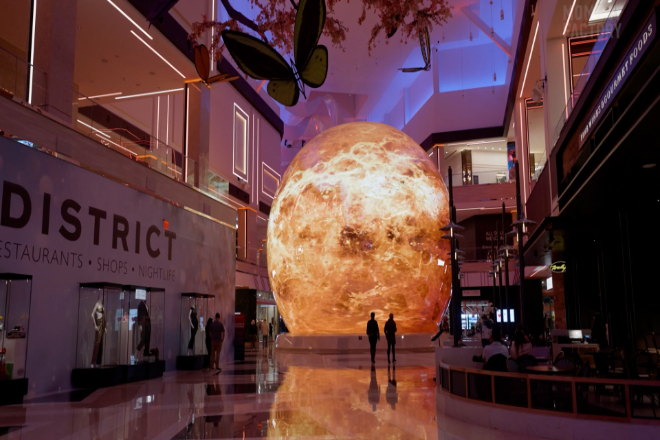
Have you ever walked into an 展示 hall and felt like you were traveling to the future? The lights flow, the pictures jump, and the information unfolds in front of your eyes in an instant.
This immersive experience is often inseparable from the blessing of LED display screens. From the ceiling to the ground, from the interactive screen to the transparent wall, they are quietly changing the way we watch exhibitions.
So, how do we use LED display screens to create a truly “high-tech” exhibition hall? This article will take you to find out.
目次
1. Advantages of LED display screens in science and technology museums
In the science and technology museum, the LED display screen is like a super painter, which can draw all kinds of scientific knowledge super realistically.
It can clearly show the little secrets in the cells and the big planets in the universe, and the colors are particularly rich, which makes people’s eyes light up.
Moreover, no matter where the audience stands, they can see the complete content, such as the spherical display screen, which can be seen 360 degrees, without worrying about the viewing angle problem. This visual effect is really great!
The LED display screen is particularly “obedient,” and the science and technology museum can use it however it wants.
It can be customized in various shapes and sizes according to the theme of the exhibition, and the content can be changed at any time, and the display effect is very personalized. More importantly, it can “chat” with the audience.
The audience can touch the screen to play games, do experiments, or use voice commands to let it display different content.
This interaction makes the visit super interesting, and the audience can better understand scientific knowledge.
The LED display is like a super teacher, which can explain complex scientific principles in a simple and interesting way.
It can use animations to demonstrate physical experiments and use videos to explain biological evolution, so that the audience can learn easily.
Moreover, it can also stimulate the interest of the audience, especially children.
Seeing these fun contents, they will take the initiative to explore scientific knowledge and fall in love with science unknowingly.
In the science and technology museum, the LED display can “transform” into various roles.
It can be placed at the entrance to welcome the audience and introduce the theme of the exhibition; it can also be hung on the wall or on the pillar to display a large area of content and save space.
In some special exhibition areas, it can be hung on the ceiling or embedded in the ground, such as simulating the starry sky or the underwater world, to bring a new immersive experience to the audience.
This diverse application makes the display of the Science and Technology Museum more colorful.
The splicing structure of the LED display makes it particularly easy to “serve.” It is easy to build and disassemble, and it is also easy to expand or replace.
Moreover, its life is particularly long, and there is almost no need to worry about the problem of breaking down.
The maintenance cost is very low, and the science and technology museum is particularly worry-free to use.
2. Key points of the design of LED display screens in the science and technology exhibition hall
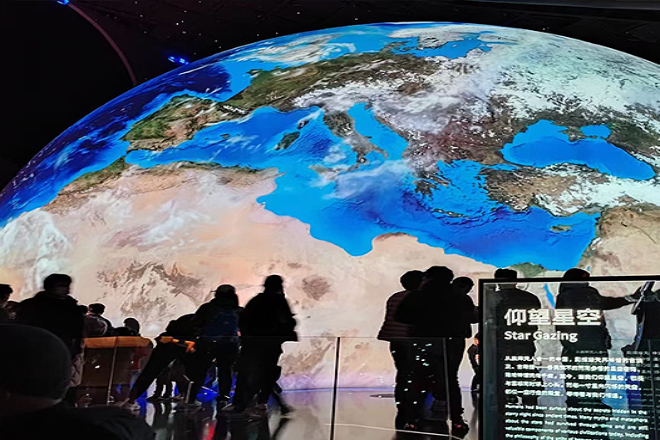
1). Space planning
The space planning of the exhibition hall is like “arranging seats” for the exhibition hall so that the audience can feel comfortable when visiting.
The functional areas are divided well, the exhibits are placed in an orderly manner, and the tour route must be smooth. The location and size of the LED display screen are very particular.
The large screen at the center or entrance of the exhibition area can attract the audience’s attention, and the small screen in the interactive area is easy to operate.
Using the height and depth of the space, the ceiling, walls, and floors are equipped with display screens to create an immersive feeling.
The exhibition hall must also be flexible. The movable and spliced display screens can adapt to different exhibition needs and improve utilization.
2). Theme positioning
The theme is the “soul” of the exhibition hall, which can string together the various elements of the exhibition hall to form an overall style. The enterprise’s exhibition hall highlights the development process and technological advantages.
The science and technology museum focuses on cutting-edge achievements, the art exhibition revolves around the creative background, and the commercial exhibition emphasizes product characteristics.
Combining technological trends, hot spots, or cultural elements, designing forward-looking and attractive themes can create a unique exhibition hall experience, attract the attention of the audience, and leave a deep impression on them.
3). Color and light and shadow
Color, light, and shadow are the keys to creating an atmosphere. The exhibition hall, with a sense of science and technology, usually uses cool colors and metallic colors; blue is mysterious, and green is fresh.
The light and shadow effect can create a flowing and staggered visual effect through the 輝度, color, and dynamic display of the LED display.
For example, when showing the Big Bang, light and shadow are used to simulate the birth of the universe, highlight the key points of the exhibits, guide the audience’s sight, and enhance the display effect and experience.
3. The application of LED display screens in the exhibition hall with a sense of science and technology
1). Information display
LED display screens are particularly powerful in displaying information, like an “information assistant.”
It can display dynamic text, charts, and data visualization content, making complex information simple and easy to understand.
For example, by using animation to show the process of cell division or using charts to show climate change data, the audience can understand it at a glance.
Moreover, it can also update information in real-time, such as news, stock quotes, and weather forecasts.
Visitors can get the latest information at any time, and the interactivity and practicality of the exhibition hall will be improved immediately.
In terms of layout design, it is also critical to arrange the location and content of the display screen according to the space of the exhibition hall and the visitor’s tour route.
For example, put the important data display screen at the entrance to attract the audience’s attention, and at the same time, ensure that this information display will not interfere with other display areas so that the information transmission of the entire exhibition hall is both efficient and orderly.
2). Multimedia interaction
The touch-type LED display screen is simply the “interactive star” in the exhibition hall. Visitors can query exhibit information, watch videos, and even participate in interactive games through touch operations.
This sense of participation and experience is super strong.
For example, in a historical exhibition hall, visitors can use the touch screen to deeply understand the background stories of ancient artifacts or watch related documentaries.
In addition to touch, LED displays can also be combined with voice recognition, gesture recognition, and other technologies to allow viewers to interact with the screen in a more natural way.
For example, viewers can use voice commands to let the screen display different content or control the playback of videos through gestures.
When designing interactive content, we should make interesting and educational content according to the theme of the exhibition hall and the needs of the audience so that the audience can learn new knowledge while having fun.
3). Virtual Reality and Augmented Reality
VR and AR technology are very popular now, and LED display screens are also very useful in them.
It can be used as a display terminal for virtual scenes and can also be used with AR devices (such as mobile phones, tablets, and AR glasses) to display augmented reality information.
For example, in a dinosaur exhibition, the audience can see the dinosaurs “come alive” in the exhibition hall through AR glasses, and the LED display screen can simultaneously display the detailed information and background stories of the dinosaurs.
When designing a VR/AR exhibition hall, it is necessary to ensure that the virtual scene and the real exhibits are naturally and harmoniously integrated.
At the same time, it is also necessary to solve problems such as technical compatibility and equipment wearing comfort, so as to bring the best immersive experience to the audience.
4. Creative LED display screens suitable for use in science and technology museums
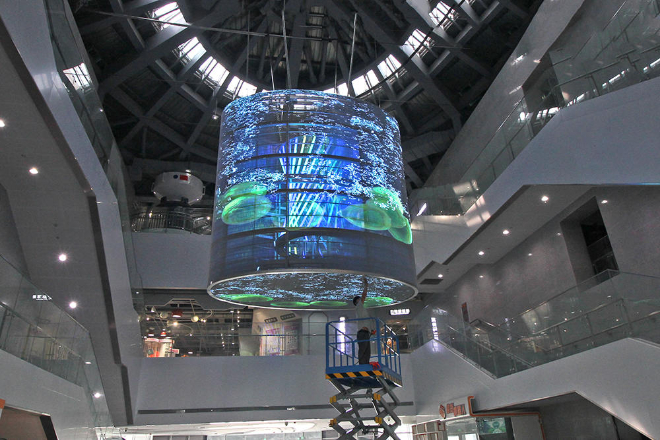
1). 透明なLED表示画面
The transparent LED display screen is like a “stealth” screen. It allows the audience to see not only the content on the screen but also the exhibits behind the screen.
This unique transparent design and high-definition display effect make the audience feel like they are in the future world.
Its structure is very clever. Its working principle is to use LED lamp beads to emit light on a transparent substrate, and the display effect is clear and transparent.
In the exhibition hall, the transparent LED display can be perfectly integrated with glass showcases and partitions.
For example, in the Luoyang Dahehui Digital Museum, a transparent LED display is installed in the glass showcase.
It can display digital content while displaying exhibits, allowing the audience to feel the perfect combination of technology and history. Pay attention to stability and beauty during installation.
Daily cleaning is also critical. You can wipe it gently with a soft cloth to maintain the transparency of the screen.
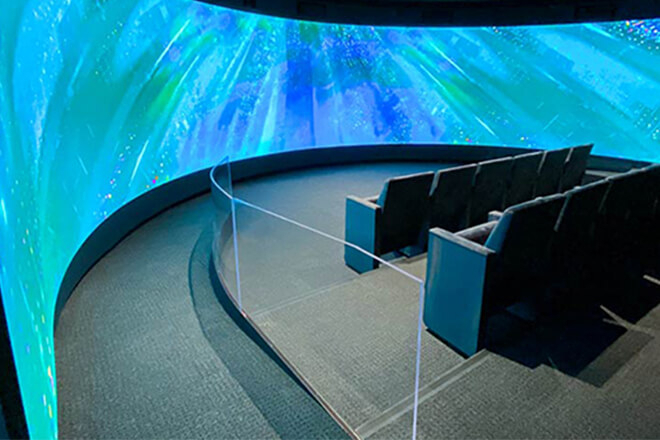
2). Curved LED display screen
The curved LED display screen is like a “Transformer” in the screen world. It can be transformed into various curved shapes according to the shape and needs of the exhibition hall.
Its technical principle is to use a special manufacturing process to allow the LED display screen to bend, thereby providing a wider viewing angle and a stronger sense of three-dimensionality.
In the exhibition hall, the curved LED display screen can create an immersive theater.
For example, in some large science and technology museums, the curved display wall makes the audience feel as if they are in the universe and the sea of stars.
During installation and maintenance, pay special attention to the flatness of the screen and the tightness of the splicing to ensure the continuity of the picture.
5. What technologies are used in the LED display screen of the Science and Technology Museum?
1). System Integration
The LED display screens in the Science and Technology Museum are not “fighting alone.”
They must work closely with other systems (such as audio, lighting, network, control system, etc.) to achieve the greatest effect.
Imagine that when the LED display screen plays a shocking video of the universe, the audio system simultaneously emits the sound of the universe, and the lighting system also adjusts the brightness and color.
This kind of coordinated operation can make the audience completely immersed in it.
To achieve this kind of coordination, it is necessary to figure out the interfaces and communication protocols between different systems to ensure that they can “have a tacit understanding” and make the display effect of the entire exhibition hall more perfect.
2). Control system selection
The control system is like the “brain” of the LED display screen. You have to choose a smart “brain” to make the display screen “obedient.”
A good control system can enable the display screen to be operated with one button. For example, the staff can switch to different display content with a light press.
Moreover, it can also realize automatic management, such as automatically turning on and off the display screen according to the opening hours of the exhibition hall or displaying different content according to different time periods.
The remote monitoring function is also very powerful. Even if the staff is not at the exhibition hall, they can remotely view the status of the display screen through a mobile phone or computer and even operate it.
There are many “plus points” in the intelligent control system, such as scene presets, which can set up display scenes in advance according to different exhibition themes and then switch with one button.
Timing control can accurately control the on and off time of the display screen, which is energy-saving and efficient.
The fault alarm function can issue an alarm in time when the display screen is abnormal so that maintenance personnel can solve the problem in the first time.
6. The budget and return on investment of the Science and Technology Museum to purchase LED display screens
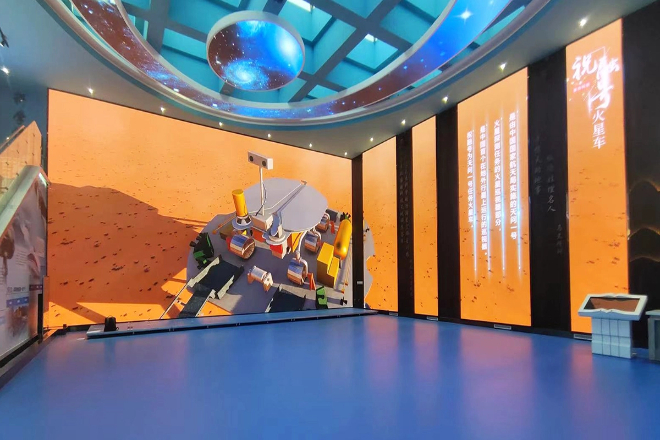
1). Cost analysis
1.1). Procurement cost
When the science and technology museum purchases LED display screens, it needs to consider factors such as the price of the display screen itself, the price of accessories, and the installation cost.
The prices of LED display screens of different types, sizes, and performances vary greatly. For example, the P6mm outdoor LED display screen used by the Canadian Science and Technology
Museum is customized in size and shape to match the unique roof lines of the museum. This high-end customized display screen is expensive.
Some conventional indoor LED display screens, such as the LED ball screen solution used by the Austrian Science and Technology Museum, are relatively affordable.
When purchasing, the science and technology museum needs to reasonably choose the appropriate display screen type according to its own budget and display needs.
1.2). Installation cost
The installation cost is affected by factors such as installation location, installation method, and wiring requirements.
For example, the LED display screen of the Canadian Science and Technology Museum is installed at the main entrance, which needs to be closely integrated with the building structure, and the installation cost is relatively high.
However, the installation cost of some conventional indoor LED displays is relatively low.
The Science and Technology Museum can effectively control the installation cost by optimizing the installation plan, selecting a professional installation team, and rationally planning the wiring.
1.3). Maintenance cost
The maintenance cost of the LED display screen mainly includes daily cleaning, regular maintenance, and fault repair costs.
High-quality display products usually have a longer service life and a lower failure rate, thereby reducing maintenance costs.
For example, the LED ball screen solution adopted by the Austrian Science and Technology Museum has a relatively low maintenance cost due to its high quality and stability.
Establishing a complete maintenance system, such as regular inspections and timely repairs, can further reduce maintenance costs.
2). Return on investment
2.1). Increased attractiveness
LED displays can attract more visitors and increase the length of time they stay by enhancing the sense of technology and interactivity of the exhibition hall.
For example, the LED display screen adopted by the Canadian Science and Technology Museum, with its high-quality display effect and avant-garde design, attracts the attention of visitors, making the museum more modern and full of science fiction in appearance.
This unique display method not only enhances the attractiveness of the exhibition hall but also enhances the audience’s sense of participation and experience, thereby increasing the visibility and influence of the exhibition hall.
2.2). Long-term operating costs
The energy-saving characteristics of LED display screens can reduce the cost of exhibition hall operations.
For example, compared with traditional display devices, conventional LED display screens have lower power consumption and longer service life, reducing energy consumption and equipment replacement costs in long-term operations.
In addition, high-quality display products usually have better stability and reliability, further reducing maintenance costs.
2.3). Brand value enhancement
The technological exhibition hall has a significant effect on enhancing the brand image.
Through advanced display technology and unique experience, the audience’s awareness and favorability of the exhibition hall brand will be enhanced, thus bringing more business opportunities and cooperation possibilities.
For example, the Canadian Science and Technology Museum has significantly enhanced its brand image as a national museum through the innovative application of LED display screens.
This increase in brand value has brought more social attention and business cooperation opportunities to the Science and Technology Museum.
7. 結論
In general, LED display screens are not only a carrier for displaying content, but also a bridge connecting technology and audiences.
It shows great potential in enhancing the attractiveness of exhibition halls, optimizing the visiting experience, and shaping brand image.
Reasonable planning and flexible application will help the Science and Technology Museum create a more futuristic exhibition space.
最後に、LEDディスプレイスクリーンについてさらに詳しく知りたい場合は、 ご連絡ください。
